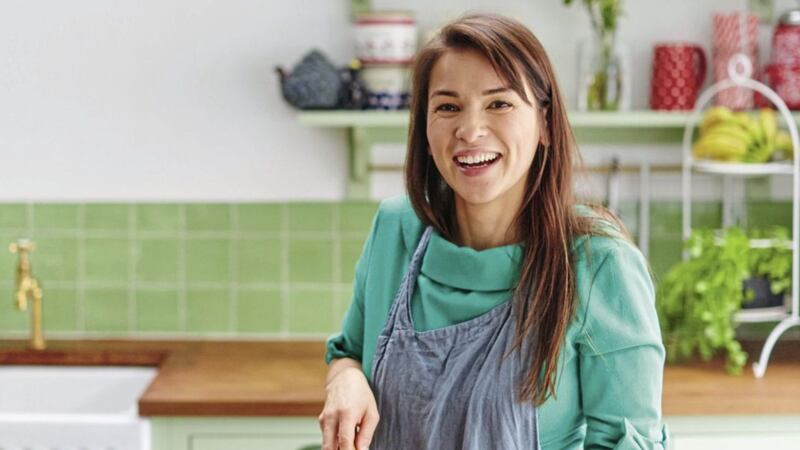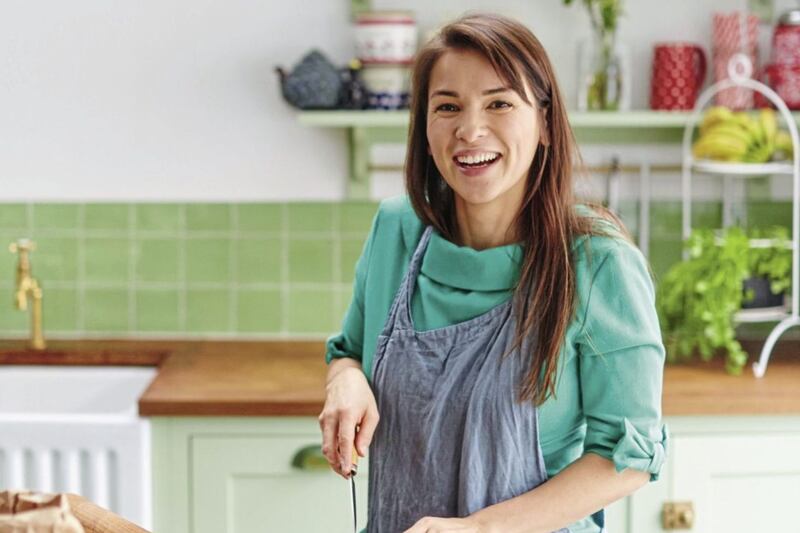WHEN you're in another country, perhaps the easiest way to begin to fathom a culture is through its food – and Rachel Khoo is an absolute expert at doing just that.
Born in south London, the food writer and presenter switched Croydon for Paris in her 20s, to study patisserie at the prestigious Le Cordon Bleu cookery school. It led to her breakout cookbook, The Little Paris Kitchen, and now it's Sweden's turn to get the Khoo treatment.
Khoo, now 37, moved to Stockholm in 2016 with her Swedish husband Robert, and The Little Swedish Kitchen sees her explore the country's tradition of 'husmanskost' – or home cooking. The focus is simple, seasonable, affordable ingredients "and making the most of what you have".
Husmanskost is a way of doing things born of Sweden's short and difficult growing season, cramped by the harsh winters. "You had cabbage, potatoes, root vegetables – that was your basis of ingredients," says Khoo. "Plus, game and seafood; you had to be creative with a small amount of ingredients." She takes this ethos and experiments (her cabbage recipes, for instance, don't involve boiling, thankfully).
Arguably, nothing is more Swedish or representative of husmanskost than meatballs. "I do some vegetarian meatballs in the cookbook," she explains, with a good-natured eye roll, "and I was told I have to include the original meat-meatballs too." They're usually served with a smooth gravy, creamy mash, tart lingonberries and tangy pickled cucumbers (yes, almost exactly like they do them at IKEA).
"You start eating meatballs as soon as you've got two teeth. The kids at kindergarten, they get meatballs for their lunch," says Khoo. "It's so much ingrained in the country – a bit like a Sunday roast for Brits – it's an everyday food that follows you from kindergarten to the canteen at work. You'll find them pretty much everywhere."
For Khoo, Sweden's attraction has always been the landscape and the nature ("It's just fields, trees, lakes, fields, trees, lakes..."). "They're very much about embracing the seasons," she says of the Swedes. "It doesn't matter whether it's summer and there are really long days and you go out in the evening and go swimming. Or, in the winter when it's dark and cold, you still go out skating, skiing and walking."
Sitting things out and blaming the weather just isn't done – hence grilling hot dogs outside in the snow isn't unusual. "They love their hot dogs," buzzes Khoo.
Other Swedish customs we really ought to take up include fika and knackebrod.
"Fika is one of the first things I learnt about," says Khoo. "[People say] 'Oh, let's go for fika' – and you meet for coffee and a bun." Flavour-wise, she recommends classic cardamom and cinnamon buns, or a brioche bun (also with cardamom), filled with almond paste and whipped cream. "It's pretty amazing," says Khoo.
Knackebrod, meanwhile, isn't a treat. The rye crispbread is a staple at breakfast, lunch and dinner, and "butter is necessary" says Khoo, explaining that how you butter your knackebrod (which is smooth on one side, and bobblier on the other) is thought to give a glimpse into your personality. "If you butter the side with more bumps, you like less butter, because on the other side, you can put more on – so you're a more generous person," says Khoo with a laugh.
She's currently learning Swedish, which will be her fourth language. "I can have a basic conversation, like the level of a two-year-old," she says. The moment she really thought she was beginning to grasp it was when she decoded Swedish favourite, gravlax. "'Grav' means 'to bury'; 'lax' means 'salmon', so you're burying your salmon in a sugar/salt mix to cure it. I was like, 'Oh! I now understand!'" she recalls proudly.
Seafood is a huge part of Swedish cuisine, although you won't find Khoo scoffing surstromming (fermented herring in a tin). "The tin bulges because of the gas," she says, screwing up her face. "You eat it outside on knackebrod; apparently it doesn't taste as bad as it smells, but it's not my cup of tea. Don't open it on public transport or you will have the whole train carriage to yourself."
More to her taste are the plump and peachy langoustines, lobster, crab and salmon hauled in along the west coast of Sweden, while inland it's crayfish territory which, come summer, means traditional Swedish crayfish parties galore (kraftskiva). Khoo describes how you drop frozen herring as bait into lobster pot-style cages, and pull them up the morning of your party, full of clacking crustaceans. They're then brined in beer, lots of salt "and dill", yelps Khoo. "You can't get enough dill!"
There's not much meat on a crayfish, though. "You have to hold the body and..." she says, making a whooshing, sucking sound, "suck all the juices out; the brine is really tasty. Then you crack it open, and you usually eat it with a vastabotten pie, similar to a cheese quiche topped with chanterelle mushrooms – and there'll be schnapps involved."
Schnapps is, of course, crucial to any Swedish party. "They love to sing their songs and drink a little schnapps," says Khoo with a smile. "It's really good fun. I don't down the whole shot, I can't keep up otherwise – too many songs."
:: The Little Swedish Kitchen by Rachel Khoo is published by Michael Joseph, priced £20. Photography David Loftus. Below are three recipes from the book for you to try.
VASTERBOTTEN PIE
(Serves 8)
For the pastry:
130g plain flour
1/4tsp fine sea salt
1tbsp wholegrain mustard
80g cold butter, cubed
1tbsp vodka
For the filling:
3 medium eggs
300ml single cream
1/2tsp fine sea salt
1tsp black pepper
300g Vasterbotten or mature Cheddar cheese, grated
1 small onion, peeled and thinly sliced
For the mushroom topping:
75g butter
250g chanterelle mushrooms, brushed clean
A small handful of fresh parsley leaves, finely chopped
Method
To make the pastry, mix together the flour and salt. Add the mustard and cold butter, then use your fingertips to rub it all together to a sandy texture. Add the vodka to bring it into a dough. Place between two sheets of baking paper and roll into a circle larger than your quiche tin (21cm, 4cm deep). Leave to chill in the fridge for 30 minutes. Preheat the oven to 180C/fan 160C/gas 4.
Remove the pastry from the fridge and use it to line the pie tin. Prick the pastry in the tin with a fork. Line with baking paper and pour in baking weights. Bake for 20 minutes, remove the baking weights and paper and bake for a further 10 minutes, or until the base is dry and firm.
To make the filling, beat the eggs with the cream, salt and pepper to a smooth mixture. Stir in the cheese. Pour into the pie case, put the onions on top and bake for 25-30 minutes, or until the mixture is set but still a little wobbly.
When the pie has cooled, heat the butter for the mushrooms in a frying pan. Add the chanterelles and cook for four to five minutes, or until lightly golden. Leave to cool slightly. Scatter the pie with parsley and top with the mushrooms to serve.
WHITE CHOCOLATE AND BERRY COCONUT MOUNTAINS
(Makes 20)
100g golden caster sugar
1/2tsp fine sea salt
Zest of 1 lemon
120g butter
200g desiccated coconut
150g sesame seeds
50g ground almonds
3 medium eggs
350g white chocolate
125g lingonberries or redcurrants
Method
Preheat the oven to 200C/fan 180°C/gas 6. Put the sugar, salt, lemon zest and butter into a saucepan and melt over a medium heat. Set aside. Pour the coconut on to a large tray lined with baking paper and place in the oven for five minutes, or until fairly well-toasted. Stir occasionally to toast evenly. When ready pour the toasted coconut into a bowl with the sesame seeds and ground almonds. Mix together, then pour in the melted butter and mix again. Add the eggs, stir together until well-combined. Leave to cool slightly.
Line a baking tray with baking paper. Form the mixture into 20 small pyramids (about 4cm high and 5cm in diameter) and set on the lined tray. Place in the oven and bake for 20-25 minutes, or until slightly golden on the peaks and firm to the touch.
Remove from the oven and leave to cool on a wire rack while melting the chocolate. Break up the chocolate and put into a small heatproof bowl over a saucepan of simmering water, ensuring the bottom of the bowl doesn't touch the water. Leave to melt, stirring occasionally. Once the chocolate has melted, dip the cakes into it and top each one with three to four berries of your choice.
ROASTED BUTTERNUT SQUASH WAFFLES
(Makes 8)
For the waffles:
300g roasted butternut squash or pumpkin
100g cooled melted butter, plus extra for greasing the waffle iron
200g buttermilk
200ml whole milk
2 medium eggs
1/2tsp ground cinnamon (optional)
1tsp fine sea salt
200g plain flour
2tsp baking powder
To serve as a sweet:
Strawberry Jam
Whipped cream
To serve as a savoury option:
4-6tbsp creme fraiche
1 red onion, peeled and finely chopped
2tbsp finely chopped fresh chives
2-4tbsp caviar
Method
Mash the roasted butternut squash or pumpkin and mix with the butter, buttermilk, whole milk and eggs. Sift together the remaining waffle ingredients into the bowl and fold to incorporate. Don't overmix or you'll get a heavy batter. Leave to rest at room temperature for 20 minutes.
Heat up your waffle iron, brushing with melted butter unless non-stick. Pour a ladle of batter into the middle. Gently close the lid and cook for a couple of minutes, or until the outside is crisp. Leave to cool for a minute before topping with the garnish of your liking.




